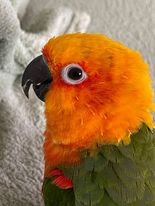As an animal communicator, my job is to translate pets’ thoughts, feelings, and viewpoints so their people can better understand them. I communicate with animals using the silent language of telepathy, which means feeling another soul or spirit over a distance. I use verbal language with humans.
 |
| Ziggy |
I recently spoke with a longtime client, Julie* and her 3-year-old jenday conure parrot, Ziggy*, about several behavioral issues that stemmed from misunderstanding each other.
I first met Ziggy at the bird rescue the day Julie adopted him a couple of years ago. He is a sweet guy, full of sunshine and joy.
Julie wants nothing more than Ziggy’s happiness. His wings are intact so he can fly around the house, and she gives him the freedom to walk on the floor and play with toys. Julie felt that giving him access outside his birdhouse was an act of love.
Previous animal communication sessions with Ziggy focused on healing two potentially dangerous and life-threatening behaviors. The first involves Ziggy pecking at Julie’s feet when he plays on the floor with his toys. Ziggy’s access to the floor created a tripping hazard for Julie that could injure Ziggy or Julie.
Since we had discussed Ziggy’s unwanted behaviors several times before, I was hopeful that Ziggy’s unwanted behavior had stopped after our last conversation with him.
That is until I received the following message from Julie, “Ziggy is still chasing my feet, and it’s getting worse. He is also chewing the heck out of my couch, trying to nest. He’s not getting the message that he must stop. So we need to talk with him to ask him again to stop.”
At the start of our next animal communication session, Julie explained that she felt frustrated since Ziggy’s scary behavior had escalated over the past several months. As Ziggy’s attacks on her feet became more aggressive, she started using a flyswatter to defend herself and make him stop. She noted that she never touched Ziggy with the flyswatter. However, the flyswatter had the opposite effect– it upset, agitated, and scared Ziggy to the point where he felt he needed to defend himself.
When I asked Ziggy telepathically how he was feeling, he shared that he felt confused about Julie’s expectations. Ziggy felt Julie’s inconsistent and sometimes aggressive behavior was part of the issue. I then shared with Julie what he told me. Ziggy asked Julie to give more guidance about what she expected of him. He explained that he attacks Julie’s feet when Ziggy has access, and he wants her attention. Julie, who works out of her home, confirmed that Ziggy is most prone to pecking her when she isn’t paying attention to him, especially when working on the phone or computer.
A new issue Julie was concerned about was Ziggy going under the blanket on the couch, where he was tearing up the sofa to nest. When I tuned into Ziggy telepathically to receive his perspective, Ziggy showed me a picture and shared how he enjoyed being snuggled under the blanket as he created a nest.
In previous sessions, I explained to Julie that it’s an act of love to set clear limits and learn to say “no” to him, especially if it will keep him safe and prevent him from ambushing her feet. Julie knows she has difficulty saying “no” to Ziggy and setting clear and consistent limits. Therefore, Ziggy was free to make his own decisions, which were not always the best or safest.
After hearing everybody’s perspective, I strongly urged Julie to be more explicit about what Ziggy is allowed to do. I also gave her permission to say no when he wasn’t following the rules. I reminded Julie that setting clear limits is about keeping Ziggy and Julie safe.
As I continued to translate Ziggy’s viewpoints for Julie, the three of us discussed different solutions to help resolve their issues.
Julie explained that she was okay putting her previous parrot in his house when she was working. It was a “light bulb” moment for Julie. She finally understood that putting Ziggy in his birdhouse was not a punishment when she couldn’t watch and supervise him.
I also recommended that Ziggy not access the floor unless Julie could carefully watch him prevent unwanted attacks and tripping over him.
Finally, I suggested that Julie spend at least 5 to 10 minutes a day meditating with Ziggy to help strengthen their bond.
After speaking with Ziggy, Julie said, “I had my first meditation session with Ziggy yesterday morning. I did half an hour. I turned on a jungle soundtrack and sat right next to him. He made some adorable noises. I guess he liked it. Also, starting yesterday, if he tries to get under the blanket, I tell him no. He got mad with me yesterday, so I put him in his house for a time-out right away. Tonight, he tried it again. I said no, so he did not go under the blanket. He’s such a good boy and very smart. I now know that I must be consistent with Ziggy. Thank you so much, my friend. Love, Julie and Ziggy.”
As pet parents, we must create clear limits and boundaries to keep them safe. When we don’t, it’s often confusing to the animal, leading to unwanted behaviors that negatively affect the relationship.
Many times, it’s up to us humans to shift our behavior to help our pets shift theirs. In the case of Julie and Ziggy, it was up to Julie to set clear, consistent limits in a calm, peaceful manner to help stop Ziggy’s aggressiveness and destructive behavior.
*To respect client privacy, their names have been changed.
















